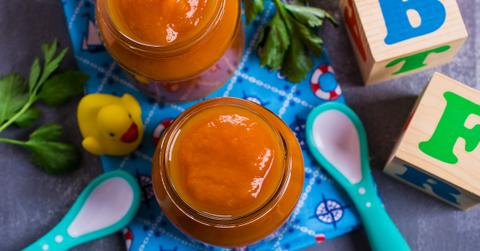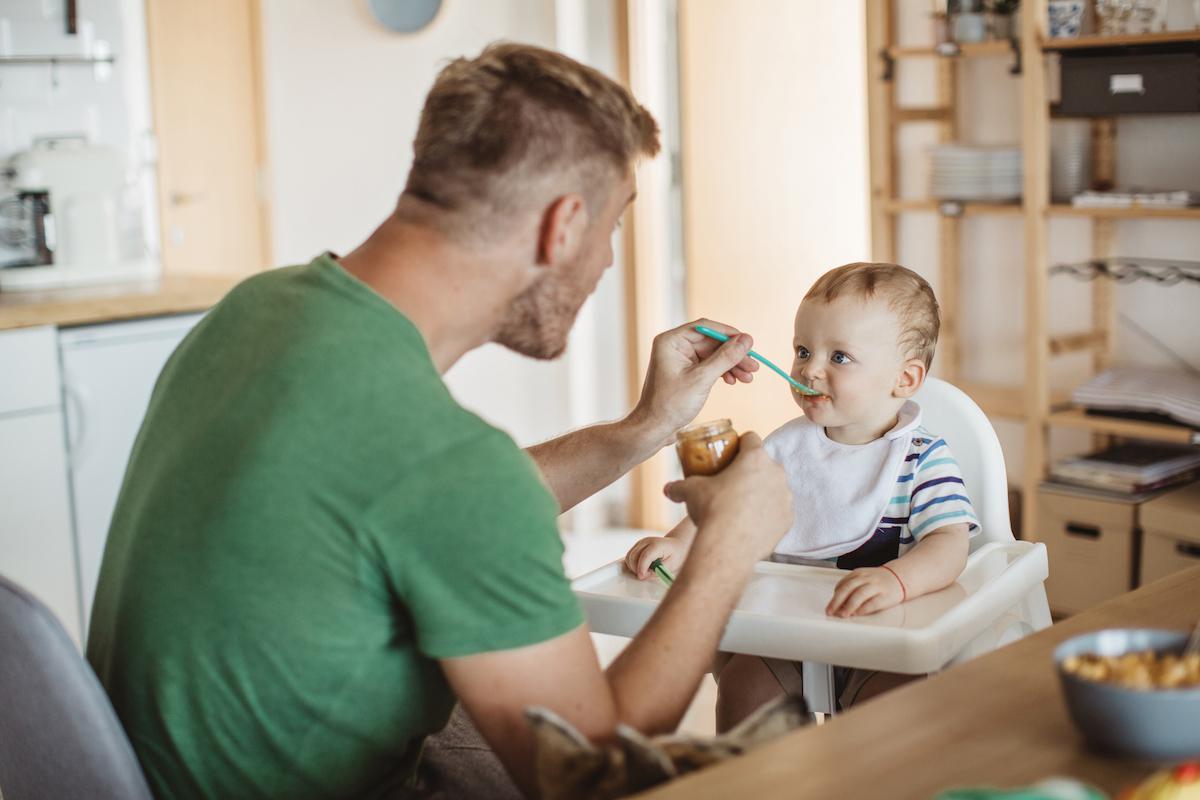How to Make Baby Food at Home
Homemade baby food doesn't have to be intimidating.
Updated Aug. 14 2019, 2:31 p.m. ET

Your baby may have a smaller appetite than you do — but somehow, you find yourself spending more on primo baby food than you spend on your own meals. (Not to mention, your baby is pooping more than you do, despite how much less they eat. Seriously, what's with that?!) But luckily, there's a pretty easy alternative to buying overpriced, tiny jars or pouches of baby food: making homemade baby food.
There are a slew of benefits to becoming your baby’s personal chef. Making your own baby food will save money, reduce packaging waste, allow you to know exactly what’s going into your baby’s meals, and with the right tools, will hardly take any time at all. Read on for our best tips on making baby food at home.
How to Make Baby Food at Home
Making baby food is as simple as thoroughly washing produce, steaming food that needs to be cooked (such as potatoes, carrots, peas, and beans), blending it up, portioning it out, and storing it safely.
One of the most important tools you’ll need to make baby food at home is a blender, food processor, or baby food maker. You will also need something to steam veggies with (whether it’s a dedicated baby-food steamer or just your stove) and food-safe storage containers — more on all that below.
At What Age Can Babies Eat Baby Food?

Both the American Academy of Pediatrics and the World Health Organization recommend introducing solid foods to your baby at around 6 months of age, while continuing to breastfeed or formula feed them until they naturally wean off (usually between 1 year and 2 years of age, though this is different for every mother and baby).
For more guidance on when your little one is ready to start eating solid foods, check out the Mayo Clinic’s list of signs — for example, if your baby is holding their head up without support, if they are putting toys and hands in their mouth, and if they are showing interest in food.
But most importantly, you should always check with your baby’s doctor for guidance on when to start feeding them solids.
What Baby Food Is Good to Give First?
When your little one first starts eating solid foods at around 6 months of age, the Academy of Nutrition and Dietetics recommends starting with single-grain infant cereal soaked in breastmilk or formula, as well as mashed or blended single foods — for example, vegetables, fruits, or beans. The Mayo Clinic suggests spacing out each new food by three to five days, just in case your baby has an allergic reaction. Once you’ve cleared certain foods, you can blend them up together to create different flavors for your baby.
When first introducing your baby to single-food recipes, all you’ll need to do is choose a few foods to blend up into their own purees. Healthline suggests starting with things like: pea puree, banana puree, avocado puree, baked sweet potato puree, apple puree, and carrot puree.
When possible, opt for organic versions of foods that are on the Dirty Dozen, which are the 12 conventional foods with the highest concentrations of pesticides in the U.S. And again, always consult your pediatrician to see if there are any foods they specifically recommend for your baby.
Baby Food Recipes for 7 Month Olds and Up
Once your baby has tried and reacted well to a variety of single-food purees, at around 7 to 9 months of age, you can introduce them to combination purees, focusing on foods they’ve already tried. Healthline recommends: spinach and white yams, beets and blueberries, avocado and banana, and butternut squash and pear.
Tasty has a few other ingredient combinations that work well for many babies starting at 7 months of age. For example: white peach and banana puree, green bean, potato, and kale puree, apple and pear butter with cinnamon, raw baby puree with blueberries, mango, and avocado, and a lentil and apple puree.
But remember, always introduce single-ingredient versions before combining to ensure there are no food allergies.
Baby Food Blenders
If you already have a blender or food processor in your kitchen, you can definitely use it to make baby food. However, some people prefer to purchase a blender specifically designed for baby food, since they often come with other helpful attachments. Here are a few well-rated options:
Baby Bullet
The Baby Bullet is made by the same company as the Magic Bullet, which is known for being a powerful, space-saving blender. The “Super Mommy Bundle” version comes with plenty of storage cups, storage trays, a rubber spatula, a baby nutrition guide, and a turbo steamer, which can quickly, cook, steam, and defrost vegetables, as well as sanitize pacifiers and bottles. It’s worth noting that while the set is convenient, most components are made of plastic.
Beaba Babycook Baby Food Maker
Beaba’s all-in-one Babycook Baby Food Maker allows you to steam, blend, and reheat baby food in under 15 minutes. The plastic bowl is dishwasher safe, there’s a descaling indicator to help keep things clean, and best of all, it comes in rose gold. There’s also a gift set version that comes with silicone baby spoons and a silicone tray for food storage.
Mash Baby Food With a Fork
For all those times you don’t feel like taking out the blender (and washing it!) there are plenty of fruits and vegetables that can easily be mashed into a smooth puree with a fork or potato masher. For example: bananas, avocados, and, if you cook them first, potatoes, sweet potatoes, butternut squash, and peas. This is generally not ideal for babies when they first start eating solids, but it’s a great option once they’ve been eating solids for a few months, and are ready for the next level.
Plastic-Free Baby Food Storage Containers
Baby food should always be served from a baby-safe plate or bowl, and not from the jar or storage container. That’s because bacteria can live in open jars, even in the fridge, especially after a used spoon has been dipped inside. That said, here are a few zero-waste storage containers you can use to keep your baby’s food safe before serving it.
Silicone Trays
The brands Kushies, Beaba, and Kiddo Feedo all make similar food-grade silicone trays that can store and freeze perfect-sized portions of homemade baby food. Each container is freezer, dishwasher, microwave, and oven safe, making them super easy to use and clean. Kiddo Feedo’s lid is also made from silicone, so it’s a completely plastic-free option, while Kushies and Beaba’s lids are made from plastic.
Glass Baby Food Jars
If you have been accumulating mini glass jars from commercial baby food, upcycling them and filling them with homemade baby food is a great option. But as an alternative, plenty of brands make mini glass jars that are the r1ight size to store baby food — check out options by Sage Spoonfuls, Minne, and Glasslock.
Silicone Reusable Food Pouches
Squeasy Snacker and Beaba both make leak-resistant, food-grade silicone squeeze bottles that can be filled with baby food. They are great alternatives to single-use baby food pouches, and as your baby gets older, they will be able to feed themselves with it on-the-go.
Plastic-Free Baby Spoons and Utensils
There are a few benefits to using spoons specially designed for kids. Metal teaspoons from the silverware drawer pose a small risk of scraping baby’s gums or teeth, while kiddie spoons are much softer. Additionally, baby spoons usually have easy-to-hold handles (for when babies start feeding themselves) and bright colors to make mealtime fun. Most baby spoons are made of plastic, but there are a few plastic-free options on the market.
Bambüsi sells spoons with bamboo handles and food-grade silicone tips, in five different colors. Olababy makes spoons from food-grade silicone, designed to comfortably fit in a baby’s hands. And Bumkins makes food-grade silicone “chewtensils” with a “choke barrier” that ensures the fork and spoon do not go too deep into your baby’s mouth.
How Long Does Homemade Baby Food Last?
While store-bought baby food can last for months unopened, homemade baby food should be stored in the refrigerator and eaten within 48 hours if it’s plant-based, and within 24 hours if it includes animal products like meat and eggs, according to FoodSafety.gov’s guide to safely preparing, storing, defrosting, and reheating baby food. Baby food can be safely frozen for up to one month, FoodSafety.gov added. The guide is filled with plenty of great insight on keeping homemade baby food safe and hygienic, so make sure to check it out before getting started.